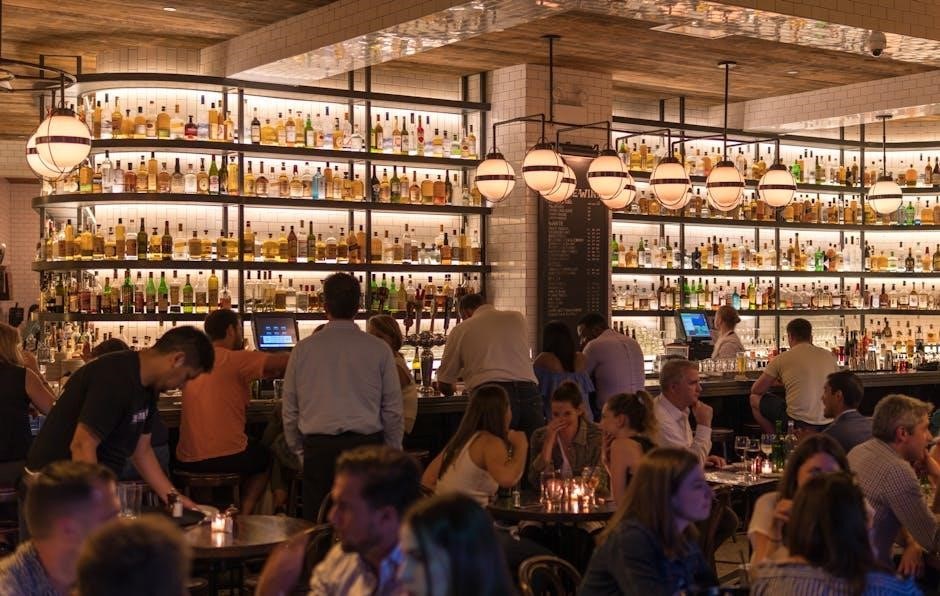
Understanding bar terminology is essential for effective communication between customers and bartenders, enhancing the overall drinking experience. It helps navigate menus, request preferences, and appreciate craft cocktails better. Whether you’re a professional mixologist or an enthusiastic drinker, mastering these terms ensures clarity and confidence in any bar setting. This guide provides a comprehensive introduction to key bar terms, helping you make informed decisions and enjoy your beverages to the fullest. Embrace the lingo and elevate your cocktail journey with precision and flair, ensuring every sip is a delightful experience tailored to your taste. Explore the world of bar terminology and unlock a universe of flavors, techniques, and traditions that define modern mixology. From measurement tools to glassware, techniques, and common phrases, this section sets the foundation for your journey into the art of bartending. Discover how each term plays a role in creating memorable drinking experiences, whether at home or in a professional bar. Expand your knowledge, refine your skills, and become a connoisseur of cocktail culture with this essential guide to bar terminology.
Measurement Terms
Measurement terms are crucial in bartending, ensuring precision and consistency. Tools like jiggers, shots, and free pours help quantify ingredients, while terms like “double” and “pony shot” specify amounts, maintaining balance and flavor in every drink.
2.1. Jigger
A jigger is a dual-sided measuring tool essential for precise cocktail preparation. Typically, one side measures 1 ounce (30ml) and the other 2 ounces (60ml), though sizes may vary. It ensures accurate pours, maintaining flavor balance and consistency in drinks. Bartenders rely on jiggers for efficiency, especially in busy environments, as they allow quick and exact measurements without spillage. This simple yet indispensable tool is a cornerstone of professional bartending, guaranteeing uniformity in every crafted cocktail.
2.2. Shot
A shot is a precise measurement of liquor, typically 1 ounce (30ml) or 1.5 ounces (45ml), served neat or used in cocktails. It’s often poured using a jigger for accuracy. Shots can be enjoyed on their own or layered in drinks, with heavier liquids at the bottom and lighter ones carefully poured on top. This technique ensures a visually appealing and balanced flavor profile in mixed beverages, making shots a fundamental component in both simple and complex bar recipes.
2.3. Pony Shot
A pony shot is a smaller measurement of liquor, typically 1 ounce (30ml), often used in layered drinks or specific cocktail recipes. It’s usually poured using a jigger to ensure precision. Unlike a standard shot, a pony shot is smaller in volume, making it ideal for drinks requiring a delicate balance of flavors. This measurement allows bartenders to craft beverages with specific ratios, ensuring consistency and quality in every serve. It’s a versatile tool in mixology, aiding in the creation of both classic and modern cocktails.
2.4. Double
A double refers to serving two standard shots of a spirit, typically 3 ounces (90ml) in total. It’s often requested for stronger cocktails or when a customer prefers a larger serving. This term is commonly used in bars to indicate a double portion of liquor, ensuring the drink is more potent. Bartenders use jiggers or free-pour techniques to measure accurately, maintaining consistency. A double is popular for those who enjoy a robust flavor profile or a longer-lasting drink, making it a frequent request in many bar settings.
2;5. Free Pour
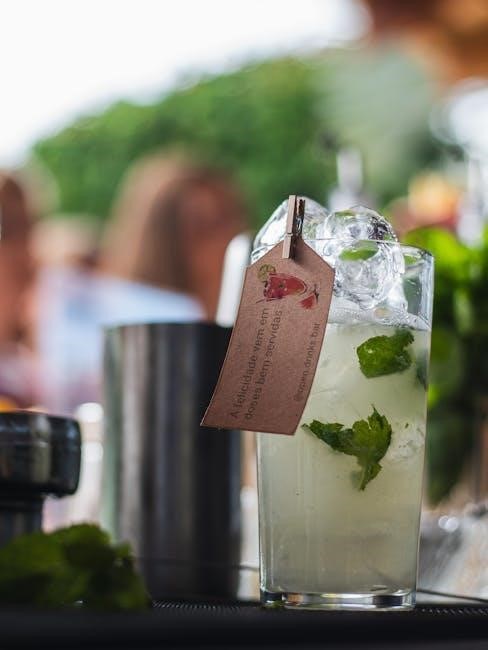
Free pour is a bartending technique where liquor is poured directly from the bottle without using a jigger or measuring tool. It relies on the bartender’s skill and experience to measure the correct amount visually. This method is often used in busy settings for speed and efficiency. Free pouring requires practice to ensure accuracy, as it depends on the bartender’s ability to judge volume. It’s a popular method in high-volume bars, allowing for quick service while maintaining drink consistency and quality.
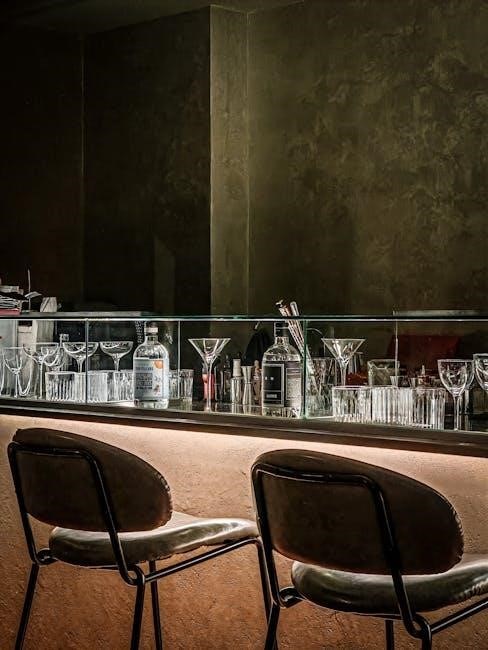
Glassware
Glassware plays a crucial role in mixology, with various shapes designed to enhance specific drinks’ aromas and flavors. From highball to martini glasses, each serves a unique purpose.
3.1. Highball Glass
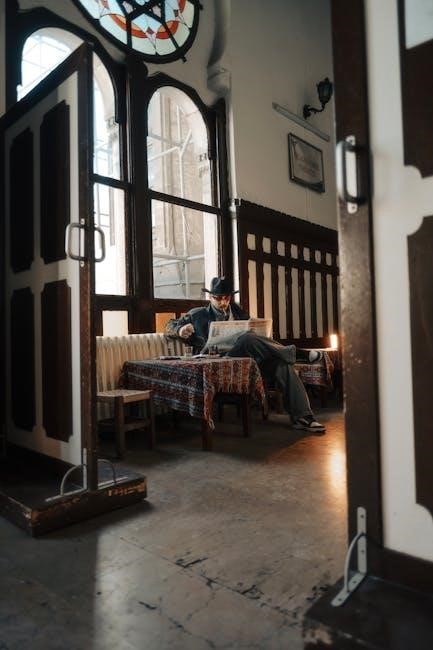
The highball glass is a tall, cylindrical glass typically used for serving mixed drinks over ice. It usually holds 10–12 ounces, making it ideal for beverages like Gin & Tonic or Rum & Coke. Its height preserves carbonation, while its wide rim allows aromas to escape, enhancing flavor. The sturdy design keeps drinks cold, making it a versatile choice for both classic and modern cocktails. This glass is a staple in every bar, ensuring refreshing and visually appealing serves.
3.2. Old Fashioned Glass
The Old Fashioned glass, also known as a rocks glass, is a short, wide-bowled glass typically used for serving whiskey, cocktails, or other spirits over ice. It usually holds 6–8 ounces, making it ideal for sipping drinks. The thick base and sturdy design allow for muddling ingredients, while the wide mouth enhances aroma release. This glass is perfect for classic cocktails like the Old Fashioned, offering a timeless and elegant way to enjoy crafted beverages. Its simplicity and functionality make it a bar essential.
3.3. Martini Glass
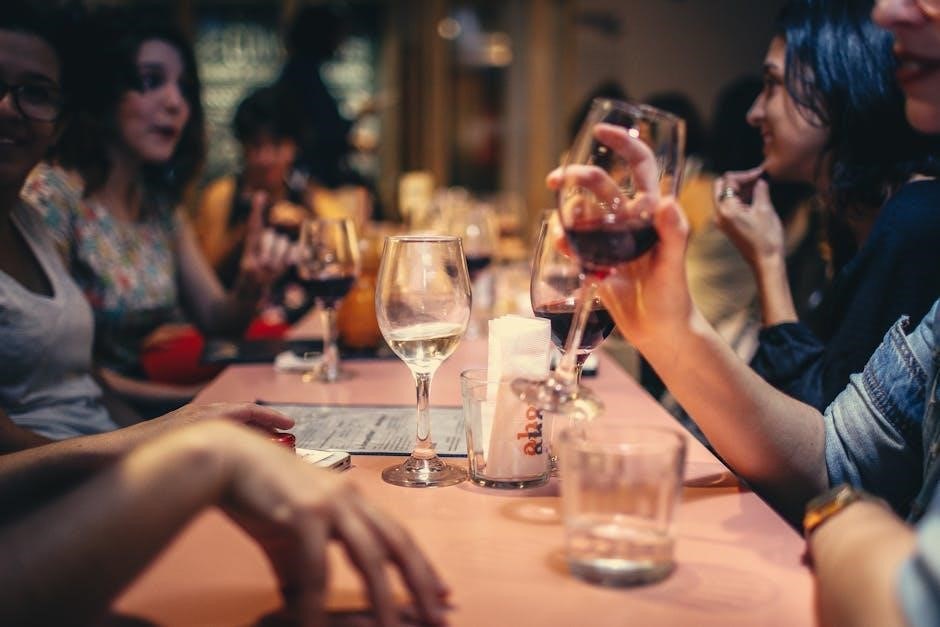
The Martini glass is a sleek, cone-shaped glass with a long stem and wide bowl, designed for chilled, clear cocktails like the Martini or Cosmopolitan. Its long stem prevents the drink from warming, while the wide mouth enhances aroma release. Typically holding 3–12 ounces, it’s a sophisticated choice for showcasing layered or clear mixtures. The glass’s design emphasizes visual appeal, making it a staple for elegant cocktail presentations. Its distinctive shape is instantly recognizable and synonymous with classic mixology and refined drinking experiences.
3.4. Coupe Glass
The Coupe glass is a stylish, saucer-shaped glass with a short stem and rounded bowl, ideal for serving cocktails like the Daiquiri or Manhattan. Its design allows for optimal aroma release while keeping drinks chilled. Typically holding 4–8 ounces, it’s a versatile and visually appealing choice for presenting layered or dressed cocktails. The Coupe glass is a popular alternative to the Martini glass, offering a sophisticated look and feel that enhances the drinking experience. Its rounded shape and sturdy base make it a favorite among bartenders and enthusiasts alike.
Mixing Techniques
Mixing techniques are fundamental in bartending, ensuring each cocktail achieves its desired texture and flavor. Methods vary, each serving a unique purpose in crafting perfect drinks.
4.1. Shaken
Shaking is a popular mixing technique used to combine ingredients in a cocktail shaker. It involves vigorous agitation, typically for 10-15 seconds, to mix, chill, and dilute the ingredients. This method incorporates air, creating a smooth, velvety texture and enhancing flavors. Commonly used for drinks with juices, creams, or eggs, shaking ensures uniformity and balance. Over-shaking can dilute the drink excessively, so timing is crucial. Techniques vary, with Boston and cobbler shakers being the most common tools for this process.
4.2. Stirred
Stirring is a fundamental mixing technique in bartending, typically used for clear cocktails like martinis or Manhattans. It involves circulating ingredients in a mixing glass with a bar spoon for 30-45 seconds to chill, dilute, and combine flavors without introducing air. This method preserves the clarity and texture of the drink, preventing over-dilution. Unlike shaking, stirring is gentler and preferred for spirits-forward cocktails to maintain their purity and balance. It ensures a smooth, refined finish, making it ideal for classic recipes requiring precision and elegance.
4.3. Built
Built refers to a mixing technique where ingredients are added directly to the serving glass without shaking or stirring. Common in drinks like the Mojito or Julep, this method involves layering components such as spirits, mixers, and garnishes in a specific order. It preserves the texture and appearance of ingredients like mint or ice, ensuring a visually appealing and flavorful drink. This technique is ideal for beverages where the integrity of ingredients matters and a layered presentation is desired for enhanced sensory experience and visual appeal. It’s a straightforward yet effective method for crafting certain classic cocktails with distinct character and texture. Built drinks often emphasize freshness and simplicity, making them a staple in modern mixology. By skipping additional mixing steps, the flavors remain vibrant and undiluted, offering a refreshing and authentic taste experience that highlights the quality of each ingredient. This approach is particularly popular for warm-weather cocktails, where the aromatic qualities of herbs and citrus shine. Built drinks are a celebration of simplicity and precision, ensuring every sip delivers the intended balance of flavors and textures. They are a testament to the art of minimalism in bartending, proving that sometimes, less manipulation leads to a more satisfying result. Whether enjoyed at a casual gathering or a sophisticated bar, built cocktails offer a delightful combination of flavor and aesthetics that never goes out of style. The built technique remains a cornerstone of bartending, allowing creativity and tradition to coexist beautifully.
4.4. Layered
Layered refers to a technique where liquids of varying densities are poured carefully to create distinct layers in a glass. This method is often used for visual appeal, with heavier ingredients like syrups or fruit juices at the bottom and lighter spirits or creams on top. A spoon or slow pouring down the side of the glass helps maintain separation. Layering enhances the drink’s aesthetic and flavor profile, allowing each layer to be experienced separately. Popular examples include the Tequila Sunrise and Harvey Wallbanger. This technique requires precision to ensure a clean separation of ingredients, making it a skillful display of bartending artistry. Layered drinks are perfect for those who appreciate both the visual presentation and the gradual tasting of flavors. They add a creative touch to cocktails, making them stand out in both appearance and taste. Mastering the layering technique is a great way to elevate your mixology skills and impress your guests with visually stunning creations. Whether for special occasions or casual gatherings, layered cocktails offer a unique and memorable drinking experience that combines art and flavor seamlessly. This method is a testament to the creativity and precision that define modern bartending, ensuring every sip is a delightful surprise. Layered drinks are a celebration of texture, color, and taste, making them a favorite among cocktail enthusiasts worldwide. The art of layering is a timeless technique that continues to inspire innovation in mixology, keeping the world of cocktails fresh and exciting. By experimenting with different ingredients and densities, bartenders can create an endless variety of layered masterpieces that captivate the senses and satisfy the palate. Layering is not just a technique but an art form that transforms ordinary drinks into extraordinary experiences. It challenges bartenders to think creatively while delivering a drink that is as visually stunning as it is flavorful. Layered cocktails are a perfect blend of science and art, demonstrating the possibilities of mixology when technique and imagination come together. They are a must-try for anyone exploring the world of craft cocktails, offering a unique journey of discovery with each sip. The layered technique is a timeless classic that continues to evolve, ensuring its place in the ever-changing landscape of bartending. Whether you’re a seasoned bartender or a curious beginner, mastering the art of layering will expand your creative horizons and delight your audience. So, next time you’re behind the bar, consider giving this technique a try and watch your drinks come to life in a whole new way. With a little practice, you’ll be crafting layered cocktails like a pro, impressing everyone with your skill and creativity. The world of mixology is full of possibilities, and layering is one technique that will always stand out, offering endless opportunities for innovation and artistic expression. Cheers to the art of layering and the magic it brings to every glass! Layered cocktails are a true marvel of bartending, combining elegance, flavor, and visual appeal in perfect harmony. They are a reminder that mixology is not just about mixing drinks but about creating memorable experiences that delight the senses. So, embrace the challenge of layering and take your cocktail game to the next level. Your taste buds—and your guests—will thank you! The art of layering is a journey worth taking, and with practice, you’ll unlock a world of possibilities that will make your cocktails truly unforgettable. Here’s to the art of layering and the endless possibilities it brings to the world of mixology!

4.5. Muddled
Muddled refers to the process of gently pressing fruits, herbs, or sugar in a cocktail shaker to release their flavors and oils. A muddler, typically a long-handled tool, is used to crush ingredients without pulverizing them. This technique enhances the aroma and taste of the drink, ensuring a balanced flavor profile. Common in cocktails like the Mojito and Old Fashioned, muddling allows bartenders to infuse fresh ingredients into the drink, creating a more vibrant and complex taste experience. It’s a fundamental technique in mixology that elevates the quality of crafted cocktails.
4.6. Blended
Blended refers to mixing ingredients with ice in a blender to create a smooth, uniform texture. This technique is commonly used for frozen cocktails like margaritas or piña coladas. The process involves combining liquids, ice, and often fruit or sweeteners, then blending until creamy and frosty. Unlike shaking or stirring, blending incorporates air and breaks down ice, resulting in a thick, velvety consistency. It’s a popular method for creating refreshing, chilled drinks perfect for warm weather or tropical-inspired flavors. Blending enhances the drink’s textural appeal and flavor balance, making it a key technique in modern mixology.
Common Cocktail Terms
Understanding common cocktail terms enhances communication and elevates the drinking experience. Terms like Dry, Flame, and Float describe specific preparations or styles, ensuring clarity when ordering or crafting drinks. These phrases, widely used in bartending, help define preferences and techniques, making them essential for both bartenders and enthusiasts to master. They add precision to cocktail creation and appreciation, ensuring every drink meets desired flavors and presentation. Familiarity with these terms bridges the gap between creativity and tradition in mixology, fostering a deeper connection with the art of cocktails. From specifying flavors to describing methods, these terms are the backbone of cocktail culture, enabling clear expression of tastes and expectations. Whether ordering at a bar or experimenting at home, knowing these terms empowers you to navigate the world of cocktails with confidence and sophistication. Embrace the lingo and elevate your cocktail journey with precision and flair, ensuring every sip is a delightful experience tailored to your taste.
5.1. Dry
In bar terminology, “Dry” refers to a cocktail, typically a martini, made with very little vermouth. This term is commonly used to indicate a preference for minimal vermouth, resulting in a spirit-forward flavor profile. For instance, a “Dry Martini” contains a small amount of dry vermouth, emphasizing the gin or vodka. The reduction of vermouth reduces sweetness and herbal notes, catering to those who prefer a drier taste. Understanding this term aids in clear communication with bartenders, ensuring the drink is prepared to one’s liking and enhancing the overall drinking experience.
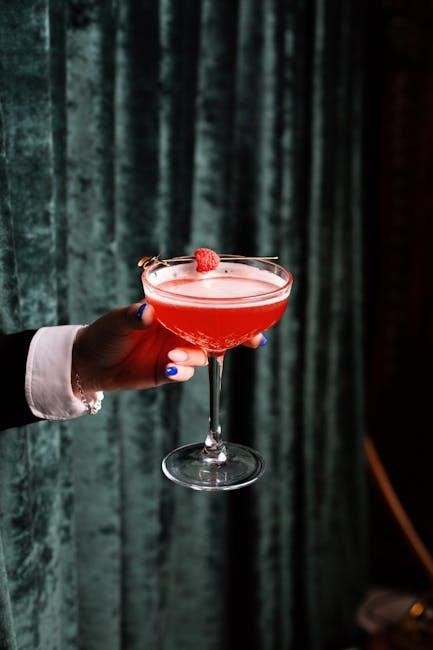
Additional Key Terms
5.2. Flame
In bar terminology, “Flame” refers to the act of setting a drink on fire, often for dramatic effect. This technique is commonly used in cocktails like the Flaming Lemon Drop or Flaming Sambuca. A sugared rim or high-proof alcohol is typically ignited, creating a brief, impressive flame. The practice requires caution and skill to avoid accidents. Flames can enhance the drinking experience visually but are primarily a novelty rather than a flavor-enhancing method. Bartenders use this technique to add excitement and theater to select beverages.